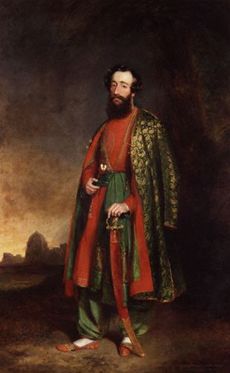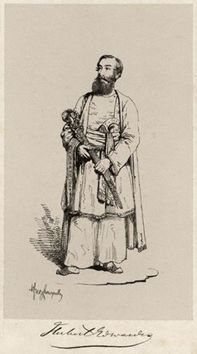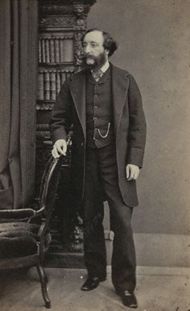Herbert Benjamin Edwardes facts for kids
Quick facts for kids
Sir Herbert Benjamin Edwardes
|
|
|---|---|

Major Herbert Benjamin Edwardes, CB, DCL (1819–1868), The Hero of Multan, dressed as an Indian nobleman, by Henry Moseley, c.1850. National Portrait Gallery, London, (NPG 1391)
|
|
| Born | 12 November 1819 Frodesley, Shropshire, United Kingdom |
| Died | 23 December 1868 (aged 49) London, United Kingdom |
| Buried |
Highgate Cemetery
|
| Allegiance | |
| Service/ |
Bengal Army |
| Years of service | 1842–1868 |
| Rank | Major-General |
| Unit | 1st Bengal European Regiment |
| Battles/wars | First Anglo-Sikh War Second Anglo-Sikh War Indian Mutiny |
| Awards | Knight Commander of the Order of the Bath Knight Commander of the Star of India Doctor of Civil Law |
| Other work | Commissioner of Ambala (1862–1865) |
Major-General Sir Herbert Benjamin Edwardes (born November 12, 1819 – died December 23, 1868) was a British soldier and leader in British India. He is famous for his important role in the Second Anglo-Sikh War. People often called him the "Hero of Multan" because of his bravery and leadership.
Contents
Early Life and Education
Herbert Edwardes was born in Frodesley, England, in 1819. He was the second son in his family. Sadly, his mother died when he was very young. His father passed away when Herbert was just four years old.
After his parents died, his religious aunt raised him. She taught him about the Protestant Christian faith, which became very important to him. He went to a boarding school in Richmond, Surrey. Later, he studied at King's College London. There, he became very interested in books and writing. He also enjoyed poetry and drawing.
Starting His Career in India
Herbert Edwardes wanted to work in India. He applied to the East India Company, which was a powerful British trading company that also governed parts of India. In 1841, when he was 22, he arrived in Calcutta, India.
He joined the Bengal Army as a Second Lieutenant. For about five years, he learned a lot about India. He became very good at Hindustani, Urdu, and Persian languages. This helped him become an interpreter. He also wrote articles for a newspaper, sharing his ideas about India. These articles were popular and caught the attention of important leaders, including the head of the Indian Army, Sir Hugh Gough.
First Anglo-Sikh War
Herbert Edwardes worked closely with Sir Hugh Gough during the First Anglo-Sikh War. This war was fought between the British and the Sikh Empire. Edwardes fought in battles like Mudki and Sobraon. He was even wounded at Mudki.
After the British won, Edwardes became an Assistant Resident in Lahore. He later helped stop a local uprising against the Maharaja of Jammu, Gulab Singh.
Building a New Town
In 1847, Edwardes was sent to a faraway area called Bannu. His job was to improve how taxes were collected there. He had only a small group of soldiers, but he used his strong personality to make big changes.
He helped end local fights and built new roads and canals. He also encouraged farming. A town he helped build was named Edwardesabad after him. Today, that town is known as Bannu.
The Second Anglo-Sikh War and "Hero of Multan"
The Second Anglo-Sikh War began in Multan. Edwardes was nearby and realized he had to act fast to stop the rebellion from spreading. He quickly gathered local fighters. On June 18, 1848, he defeated a rebel group. Later, he won another battle near Multan. During this time, he accidentally hurt his right hand with his pistol.
Edwardes then forced the rebels into the fort of Multan. He helped lead a siege until the rebels surrendered in January 1849. His actions were praised by many, including Sir Henry Lawrence, who said Edwardes had done as much as Clive, another famous British leader in India. Edwardes was promoted and given an award called the Companion of the Order of the Bath (CB).
He returned to England as a hero. He received an honorary degree from Oxford University. In 1850, he married Emma Sidney. He also wrote a two-volume book about his experiences called A Year on the Punjab Frontier.
Treaty with Afghanistan
Edwardes believed that having a strong and independent Afghanistan would help protect British India from other powerful countries. He suggested that Britain sign a friendship treaty with the leader of Afghanistan, Dost Mohammad Khan.
Even though some leaders disagreed, Edwardes's idea was approved. The treaty was signed in 1855. It was very important because it helped keep peace in the region during the Indian Rebellion of 1857 two years later. This peace allowed British troops from Punjab to help in other parts of India.
Indian Rebellion of 1857
When the Indian Rebellion of 1857 broke out, Edwardes was given permission to raise local troops in Punjab. These troops helped keep order in Punjab. Later, many of these troops were sent to help in the Siege of Delhi. This brave decision by Sir John Lawrence, who risked leaving Punjab less protected, earned him the nickname "The Saviour of India."
Return to England and Later Life
In 1859, Edwardes returned to England because his health was not good. While there, he received more honors, including being made a Knight Commander of the Order of the Bath (KCB). He also received another honorary degree from the University of Cambridge.
In 1862, his health improved, and he returned to India. He took on an important role as Commissioner of Ambala. However, after three years, his health and his wife's health worsened, and they left India for good in 1865.
Back in England, he continued to be recognized for his service. He was made a Knight Commander of the Order of the Star of India (KCSI) in 1866 and promoted to Major-General in 1868. Herbert Edwardes died in London on December 23, 1868, at the age of 49. He is buried in Highgate Cemetery.
His Christian Faith
Herbert Edwardes was a very religious Christian. He believed strongly in spreading Christian teachings in India. He supported Christian missions and schools. For example, he helped establish the first school in Peshawar in 1853, which is now the High School, Kohati Gate Peshawar, Pakistan. He also served as a leader for the Church Missionary Society.
Literary Works
- A Year on the Punjab Frontier, 2 volumes, 1851.
- Political Diaries of Lieut. H. B. Edwardes, Assistant to the Resident at Lahore 1847 – 1849, Sang-e-Meel Publications, Lahore, Pakistan 2006 (Reprint version) ISBN: 969-35-1770-9
Commemorations
- Edwardes College, Peshawar, North West Frontier Province (NWFP), Pakistan.
- Edwardesabad (now Bannu), NWFP, Pakistan.
- Edwardes High School kohati gate Peshawar Pakistan.
Images for kids
Sources
 "Edwardes, Herbert Benjamin". Dictionary of National Biography 17. (1889). Ed. Leslie Stephen. London: Smith, Elder & Co.
"Edwardes, Herbert Benjamin". Dictionary of National Biography 17. (1889). Ed. Leslie Stephen. London: Smith, Elder & Co.




